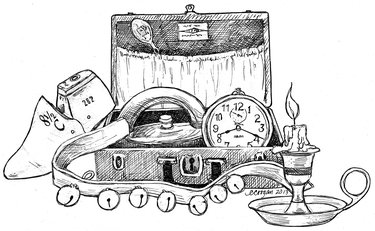Objects are mute tellers of history
One hot summer day, we stood in a long line in the rotunda of the National Archives Building in Washington, D.C. Like everyone else in that line, we were waiting our turn to glimpse the Bill of Rights.
It was worth the wait.
There were the familiar words, the words that had helped shape a nation. We were surprised at how fragile, how delicate the penned words looked. We had seen them only in print and knew of their force in our daily lives as journalists.
But seeing the physical object thrilled and informed us in ways we hadn’t anticipated.
Objects need not be so singular nor so seminal as the Bill of Rights to inform us of our past or to enlighten our future.
We know someone who keeps an old baseball on his desk. It’s made of horsehide and was stitched by hand at an Albany company that no longer exists. In a world now dominated by mass-produced synthetics, he simply likes the feel of it in his hand.
Objects are mute tellers of history.
We perused this week a list of objects — compiled by Mary Kinnaird, a retired Berne-Knox-Westerlo teacher — to show to Hilltown children. Children looking at a “cobbler shoe form” would realize cordwainers once made shoes by hand, sometimes stitched to fit a particular foot. Some of their lasts were for a left foot or right foot; others were straight and the wearer’s foot did the fitting.
A “soapstone bed warmer” would let the kids realize what homes were like before central heating. A family would have to disperse from the warmth of the hearth to retire to distant cold bedrooms where the soapstone would bring warmth and comfort.
Shaking “sleigh bells,” the children, of course, would be able to sing “Jingle Bells” and probably picture a Christmas scene of a horse-drawn sleigh. But they might also make the leap to envision life without the ubiquitous automobile if they realized that sleigh bells had a practical use, too. When it was dark or foggy, the bells would warn other travelers of the sleigh’s approach. And, since sleighs are slow to stop, such warning could literally be a lifesaver.
These artifacts and more are part of a project called “Suitcases of History” launched this year by the Helderberg Hilltowns Association. We commend the project for several reasons and believe it may serve as a useful model for others.
First and foremost, it allows children to hold history in their hands, to let objects tell stories in a way that is concrete and memorable.
A student can read about the Civil War, for example, but to hold in her hands a diary written by G. H. Warner, a soldier from Berne who served in New York’s 177th Infantry, brings that history home.
Second, we commend the project for the way it was created. The historical societies of Berne and Knox along with the curator of the Altamont Archives and Museum worked with the schoolteachers and the association to put the project together. That, in itself, is a worthwhile lesson for the children to learn.
Working together can make something better and richer.
Finally, another lesson that, like the others, may be carried beyond childhood: Obstacles can be conquered with creativity, cooperation, and perseverance.
The obstacle in this case was a lack of school funds for field trips.
“Since the schools have almost no money for field trips anymore, we would like to help create a way to bring history to the students,” Zenie Gladieux, president of the Helderberg Hilltowns Association, wrote in May 2012 in an e-mail to those who might be interested in organizing such a project.
That project, through the dedicated and concerted efforts of a diverse group, has now come to fruition. We believe the results may be better than a field trip.
Over the years, we’ve covered many fund-raisers for and class trips to places like amusement parks. Even if BKW could afford to send its students to the granddaddy of all amusement parks, Disney World, we believe these humble suitcases may provide for richer travels in the long journey of life.
Not because they better correlate to the Common Core State Standards. But because the kids already know about Mickey Mouse and Cinderella’s Castle; they have dominated our national imagination for decades.
Once the suitcase is open, what the children hold in their hands will be real and true — a part of their own history, and maybe even a guide to their informed future.
— Melissa Hale-Spencer


